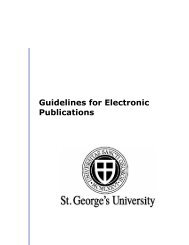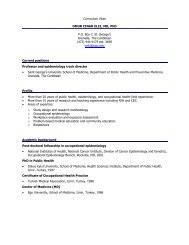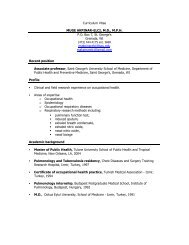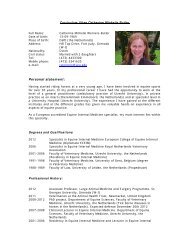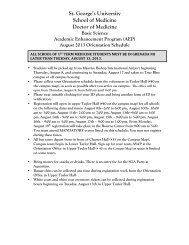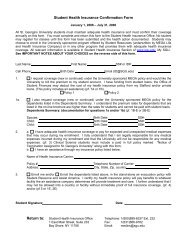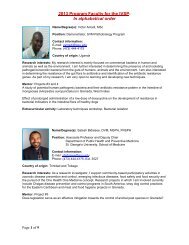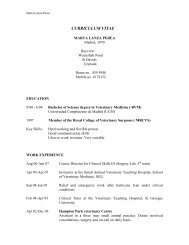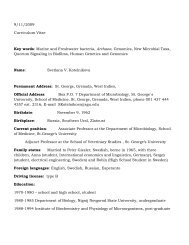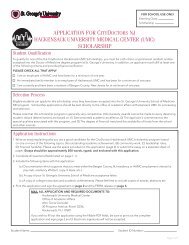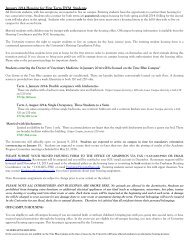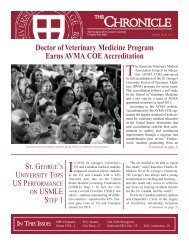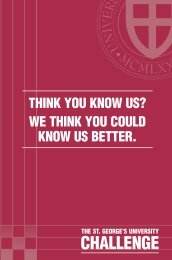SCHOOL OF 2012-2013 - St. George's University
SCHOOL OF 2012-2013 - St. George's University
SCHOOL OF 2012-2013 - St. George's University
You also want an ePaper? Increase the reach of your titles
YUMPU automatically turns print PDFs into web optimized ePapers that Google loves.
upon the major theoretical perspectives are covered and<br />
empirically based treatment outcome studies are reviewed.<br />
SSCI 412<br />
Social Science and Medicine<br />
This course examines several aspects of medicine. First, it<br />
examines how the health care system is a social institution<br />
with norms and belief systems that may differ in other<br />
cultures. Second, the doctor-patient relationship is<br />
examined and the concepts of doctor communication,<br />
patient adherence, and compliance, in addition to types<br />
of health care delivery, are highlighted. Third, behavior<br />
and how it affects patient health is examined. Specifically,<br />
the course discusses stress, personality, drug use, alcohol,<br />
smoking, diet, and pain management as important factors<br />
contributing to a person’s health. As fewer people die from<br />
infectious diseases and more people die from diseases<br />
(such as cancer) that may be prevented through a healthy<br />
lifestyle, understanding patients’ lifestyles outside of<br />
the hospital is imperative. Overall, the course discusses<br />
health and illness within the biopsychosocial model that is<br />
replacing the biomedical model in medicine.<br />
Doctor of Medicine Program<br />
The medical program curriculum is divided into two<br />
segments, the Basic Medical Sciences and the Clinical<br />
Years.<br />
Basic Medical Sciences Courses<br />
The following descriptions are overviews of the Basic<br />
Medical Sciences courses. The subject matter and course<br />
objectives will continually change to reflect advances and<br />
new directions within the discipline, as well as growth<br />
and new dimensions within the faculty and academic<br />
community of the School.<br />
Anatomical Sciences<br />
Marios Loukas, MD, PhD, Chair<br />
ANAT 531<br />
Histology and Cell Biology<br />
This course presents the structure and function of<br />
the human body as revealed by light and electron<br />
microscopy, as well as cell biological techniques, such as<br />
immunocytochemistry. The course commences with a<br />
discussion of the cell and its internal structures. <strong>St</strong>udents<br />
are introduced to the concepts of how cells interact with<br />
each other and their external environment. Cell signaling,<br />
cell secretion, the cell cycle, and the extracellular matrix<br />
are some of the topics presented in the analysis of cell<br />
structure and function.<br />
<strong>St</strong>udents’ mastery of cell structure and function leads to<br />
the organization of cells into the four basic tissues of the<br />
body. Each of these is presented with emphasis on the<br />
role of cells in tissue organization and function. The cellular<br />
nature of the tissues and the interactions of cells with the<br />
extracellular matrix are stressed so that students have a<br />
firm understanding of the concept of a histological tissue.<br />
An understanding of the four basic tissues is paramount to<br />
students becoming complete and modern physicians.<br />
The basic tissues of the body are then arranged into the<br />
organs and organ systems. Once again, the cellular aspects<br />
of organ structure and function are emphasized because<br />
cells in the various organs are the main contributors to the<br />
function of those organs.<br />
The emphasis on the cell in histology and cell biology<br />
cannot be overly stressed since all diseases occur at<br />
the cellular level. Thus, students must understand the<br />
basic science of the cell and its mechanisms before they<br />
can understand how pathologies work. In addition, cell<br />
structure and function as presented in this course serves<br />
as preparation for the elaboration of these concepts in the<br />
physiology and pharmacology courses, and will prepare<br />
students to be lifelong learners of medicine. The students<br />
are taught learning skills and gain knowledge about<br />
information that is an absolute necessity for the modern<br />
physician.<br />
ANAT 550<br />
Human Gross and Developmental Anatomy<br />
The course in human gross and developmental anatomy<br />
consists of approximately 160 scheduled class hours<br />
devoted to cultivating an appreciation of a threedimensional<br />
visual image of the human body and its<br />
development. Formal lectures present integrated<br />
general and applied anatomy, imaging, clinical anatomy,<br />
developmental anatomy, and clinical embryology. Specific<br />
objectives are provided to facilitate learning, in addition<br />
to reading the required text and anatomical atlas. All<br />
lectures and laboratory sessions are available through the<br />
<strong>University</strong> website on SAKAI, which also provides online<br />
School of Medicine<br />
Course Descriptions<br />
School of Medicine Catalog <strong>2013</strong>–2014 | 57



